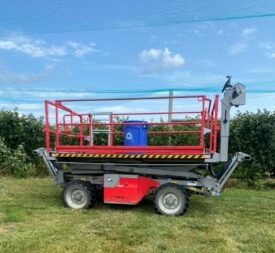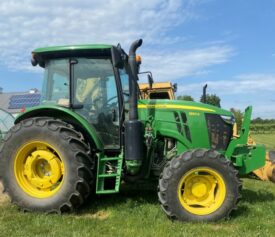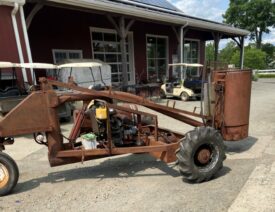by Gary Mount
 This is a story about farmers and their machines. I recently counted the number of different types of machines that I use on our 250-acre fruit and vegetable farm–over 47. Many of the machines have multiple examples of that type–for instance 7 pickup trucks, 9 golf carts ,4 mowers, *** tractors (we never mention how many tractors), 11 wagons, 3 plows–if I kept going, I would easily get over 100 total. Having so many machines makes it possible to get the work done in growing and harvesting our many crops.
This is a story about farmers and their machines. I recently counted the number of different types of machines that I use on our 250-acre fruit and vegetable farm–over 47. Many of the machines have multiple examples of that type–for instance 7 pickup trucks, 9 golf carts ,4 mowers, *** tractors (we never mention how many tractors), 11 wagons, 3 plows–if I kept going, I would easily get over 100 total. Having so many machines makes it possible to get the work done in growing and harvesting our many crops.
But bailing wire–what’s that about? All early farms raised animals as well as crops. Grass was grown and cut to store away so that the animals could be fed in the winter. The grass was cut and dried, then stacked, loose, on a wagon, taken to the barn and stacked, loose, and then fed all winter- always being handled-loose- usually with a pitchfork.
A very valuable early machine that compressed and wrapped the grass, called hay, into bales was a hay baler. It wrapped bailing wire– a smooth wire of good strength around a compressed block of hay making for more efficient handling of hay. I am certain that bailing wire quickly became indispensable to keep the very machine that used it in working condition. It has been important in fixing broken farm machines ever since which brings up the point of this farm story–farm machines always need fixing. If you have, as I do, over 47 types of machines and over 130 in all, that is a lot of fixing.
I grew up on a large farm with lots of machines, but not so many different types of machines. My father only grew one crop- apples-so the list of machinery types was shorter. But bailing wire was essential. I remember “fixing” a balky pump. Lots of bailing wire was involved. So much so that it took my father over half an hour to cut it all off when he came to fix the pump properly (which meant fixing it his way). I did become more adept at fixing machines, especially after the time that I was 11 years old and with my brother Lee, bought a 1930 Model A Ford car. More bailing wire! I became better and better at fixing, especially learning from Lee, three years older and who has always been a better “fixer” than me. It has helped all through my life. Even when Pam and I were Peace Corps Volunteers on a small pacific island, my farm boy mechanical ability was helpful. A radio and generator, for instance, was sent to every island that hosted a volunteer. When a generator did not work the volunteer was cut off from the outside world and he or she was supposed to return to the district center, Yap Island, on the next ship (somehow, none ever did).
I kept our generator working. Once I sailed to another island 50 miles distant to fix their generator. I even managed to start a diesel generator with the assist of an array of flashlight batteries and a group of Islanders pulling on a rope, an event that was still talked about when we visited the island 20 years later!
My fix-it adventures in the Peace Corps have been overshadowed by the task of keeping the Terhune farm equipment working. An early farm equipment purchase was a “hydro ladder” in 1976. A three-wheel orchard lift (see picture)- pretty simple-that helped in the care of our newly purchased orchard which was filled with 24-foot tall apple trees. This machine merits mention not because of difficulty in repair but in its longevity, which in this case meant a continuum of repair. The manufacturer has long ago gone out of business, but we still use it (and fix it) 47 years later- not only for the care of the few large trees still left but for many of the jobs on the farm. And, as I tell my helpers on the farm, if a machine breaks, it does not heal itself. It is up to us to fix it!
The most frustrating of repair jobs is the one that has to be done on someone else’s machine that you have borrowed. If a friend has loaned it and it has broken while you use it, you must fix it—without question. In 1981 we planted 10,000 apple trees on our 13 Van Kirk Road farm and in doing so, bent a tree planter borrowed from a fellow fruit grower. It was an expensive repair, and the machine still did not belong to me. Groan.
The hydro ladder has been far surpassed in complexity by one of my latest acquisitions, an Orsi orchard platform made in Italy. It is great (see picture). It’s self-steering, all-wheel drive, has a scissor lift to raise and lower the platform bed, forklifts front and back to handle bins of apples, and an air compressor to power tree care tools. It is something! –We use it all the time to care for our orchards, to harvest fruit and to erect bird netting over sensitive crops. Unfortunately, it was made in Italy. Not only did it come without an owner’s manual—not even one in Italian– but although Italian equipment design is the best in the world– elegant really– durability and freedom from repair are not part of the package.
The last picture in this story is of our latest tractor purchase–a John Deere. It is very powerful and handy- we use it all the time. Unfortunately, it has a major fault. The John Deere company has designed it to be so complicated that the owner/farmer cannot repair it himself. This is a major issue in the agricultural community. Farmers feel that if they own the machine, it is their right to repair it. And bailing wire will just not do.


